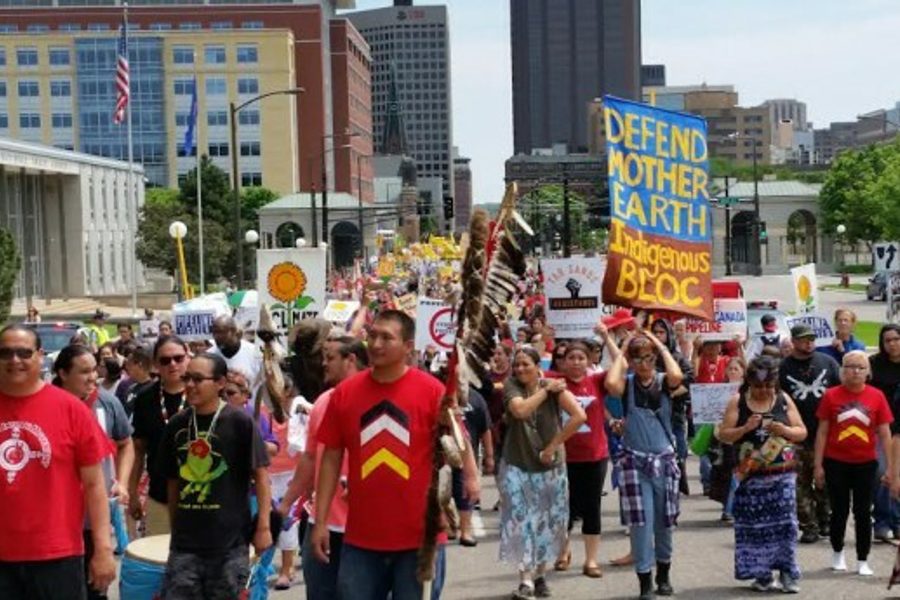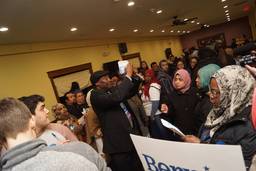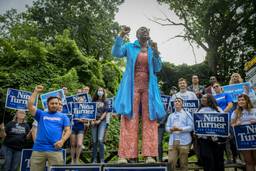#NoTarSands Resistance March Draws Thousands in Midwest
Indigenous activists from the 200 Great Lakes Indians lead thousands to say to #NoTarSands in the largest anti-tar sands demonstration in Midwest history.
David Goodner

This story first appeared at Waging Nonviolence
The stories of frontline indigenous communities in the fight against Big Oil pipelines took center stage on Saturday, as more than 200 Great Lakes Indians led a crowd of nearly 3,000 (mostly white) people to the steps of the Minnesota state capitol in what is being called the largest anti-tar sands demonstration in Midwest history.
The smell of burning sage sweetened the city air as war cries and thundering drums boomed down skyscraper streets. Spiritual songs mixed with protest chants. Tribal dancers, followed by raucous college students, kept the pace.
“The fossil fuel industry thinks it is powerful, but it is the water and the people that are powerful,” said Sharon Day, an Ojibwe leader with the Indigenous People’s Taskforce. “These waterways are our lifeblood. If you want your grandchildren’s grandchildren to have life and clean water, then we must all do what we can.”
Tribal groups, like the Ojibwe on the White Earth Nation reservation in northern Minnesota, say tar sands and Bakken oil pipelines — such as the proposed Alberta Clipper expansion and Enbridge Sandpiper — threaten the wild rice fields of their ancestral territory.
“We are fighting four different pipeline proposals by Enbridge Energy and the Koch brothers,” said Winona LaDuke of Honor the Earth.
Indigenous leaders came all the way from Canada, from the very heart of tar sands oil production, and their stories invoked a broad climate justice narrative that also addressed the intersections between colonialism and violence against women, people and the land.
“In Canada, we have more than 1,200 missing or murdered women,” said Melissa Daniels of the Athabasca Chipewyan First Nation. “They are using an oppressive, genocidal policy to continue this exploitive capitalist system, destroy our water and destroy our people.”
Indigenous people weren’t the only frontline communities at Saturday’s tar sands resistance march. Ranchers, family farmers and rural landowners fighting dozens of frac sand mines and three tar sands and Bakken oil pipeline proposals came to St. Paul from neighboring states like South Dakota, Nebraska, Iowa and Wisconsin.
John and Jane Fisher-Merritt are organic farmers from Wrenshall, Minnesota and members of the Carlton County Land Stewards who fought to keep Enbridge Sandpiper from plowing through 360 acres of timber, waterways and vegetable gardens. They partially succeeded, but the big oil corporation only agreed to move the proposed pipeline route less than two miles south of the Fisher-Merritt family’s Food Farm.
“We came to the rally today because we wanted to lend our voices to the chorus of people opposed to these pipelines,” said John, who was angry at state regulators and their recent unanimous vote to certify a new oil pipeline for construction. “It’s so exasperating that a foreign corporation like Enbridge is given a certificate of need from the Minnesota Public Utilities Commission even though the oil isn’t needed here and is just being transported through the state on the way to somewhere else.”
Aside from the farmers, a small number of African Americans attended Saturday’s climate march. Rev. Lennox Yearwood of the Hip-Hop Caucus was a featured speaker at the capitol rally, as was Emma Lockridge — a resident of inner-city Detroit, who lives next to a tar sands oil refinery.
“We talk about the horror of the tar sands, we talk about the horror of the spill on the Kalamazoo River, but at the end of the day, the oil comes out to my community,” Lockridge said. “My home smells. We can’t breathe. We wake up with headaches, coughing. We can’t go outside.”
Lockridge lives in a community already polluted by trash incinerators and coal plants, but says the tar sands oil refinery is the worst of the worst. White homeowners were offered buyouts, but the neighborhood’s black residents were stranded without any private or public support.
“They have to let us out or we are going to die. They gave white people money to leave so why can’t we leave?” Lockridge asked. “It all needs to go. From coast to coast. All the pipelines. All the refineries. All the trains. I don’t care if its tar sands or hydraulic fracking. At the end of the pipeline there are people who look like me and we’re dying.”
The #NoTarSands event was organized by 350.org, the Sierra Club and the Indigenous Environmental Network, and endorsed by dozens of national, state and local organizations. It marks a turning point for the mainstream climate movement, as national environmental leaders strive to deepen a burgeoning relationship with frontline indigenous and rural farming communities, as well as broaden their campaign against the Keystone XL pipeline to include other proposals like the Alberta Clipper expansion, and the Enbridge Sandpiper and Dakota Access pipelines.
“Every pipeline in America, every pipeline in the world, is going to be fought from now on,” national movement leader Bill McKibben said during a post-march rally at the Minnesota capitol.
McKibben helped launch the current wave of climate action in 2011 after his organization, 350.org, organized a two week sit-in at the White House, resulting in more than 1,200 arrests. While mass gatherings orchestrated with the approval and assistance of law enforcement, like Saturday’s march, have dominated national strategy in recent years, some demonstrators in St. Paul seemed hungrier for civil disobedience.
“I see this is called a resistance march, but where is the resistance?” asked Phyllis Roden, an activist from Minneapolis. “We better be ready to get our asses in the streets and really resist. We shouldn’t just march to the capitol, we should surround it until they haul us all off to jail. That’s the only way they’ll really start listening.”
It’s not immediately clear what national organizers have planned next, but local, county and state-based indigenous and family farm groups need more financial resources and direct action training. Plugging into a wave of decentralized #FloodtheSystem protests next fall could be a logical next step.

I hope you found this article important. Before you leave, I want to ask you to consider supporting our work with a donation. In These Times needs readers like you to help sustain our mission. We don’t depend on—or want—corporate advertising or deep-pocketed billionaires to fund our journalism. We’re supported by you, the reader, so we can focus on covering the issues that matter most to the progressive movement without fear or compromise.
Our work isn’t hidden behind a paywall because of people like you who support our journalism. We want to keep it that way. If you value the work we do and the movements we cover, please consider donating to In These Times.






